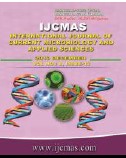


 National Academy of Agricultural Sciences (NAAS)
National Academy of Agricultural Sciences (NAAS)

|
PRINT ISSN : 2319-7692
Online ISSN : 2319-7706 Issues : 12 per year Publisher : Excellent Publishers Email : editorijcmas@gmail.com / submit@ijcmas.com Editor-in-chief: Dr.M.Prakash Index Copernicus ICV 2018: 95.39 NAAS RATING 2020: 5.38 |
Long term exhaustive cropping practice and indiscriminate use of poor quality water can result in accumulation of salts and sodium that adversely affect crop growth. Salinity and sodicity are the major soil degradation issues primarily in arid and semi-arid regions of the world. The sustainability of agriculture is a matter of deep concern due to widespread removal of nutrients in excess of their application resulting in depletion of major soil nutrient reserves. Nitrogen (N) use efficiency of applied N in saline and sodic soils is low. Adequate N fertilizer dose, method and time of application are essential to increase its efficiency. Phosphorus (P) is one of the limiting major nutrient elements in salt affected soils. In saline soils, availability of P decreases due to precipitation of applied P, higher retention of soluble P, antagonism due to excess of chlorides (Cl-) and sulphates (SO42-). Potassium (K) deficiency is observed under high soil-Na concentration. Phosphorus and K availability in saline and saline-sodic soil increases with crop residue incorporation. In this paper, we reviewed the major nutrients dynamics in saline and sodic environment and their proper management strategies.
 |
 |
 |
 |
 |